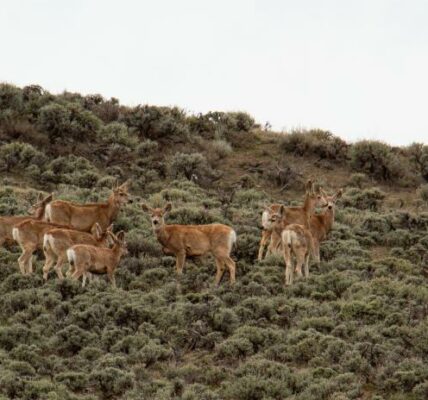By Mike Koshmrl
Jackson Hole News&Guide
Via- Wyoming News Exchange

JACKSON — A new type of industrial activity is rising from the sagebrush and pastureland in western Wyoming: utility- scale solar farms.
Three such developments have already been constructed or will soon be built in the Green and Bear river basins. The introduction of photovoltaic renewable energy technology figures to help replenish county coffers and reduce reliance on flagging fossil- fuel industries, but it’s also causing worries about viewscapes, sage grouse and pronghorn.
The lone existing large solar farm, dubbed Sweetwater Solar, located between Seedskadee National Wildlife Refuge and Interstate 80, made headlines in December, when about 1,000 pronghorn were bottlenecked and funneled toward a highway by the new 1-square-mile expanse of solar panels circled by a fence. With less media fanfare, Lincoln County pushed an 80-megawatt solar farm through its approval processes two years ago. Then on Jan. 8, its Board of Commissioners signed off on a second 80-megawatt phase of the project nearby.
Lincoln County Planning Director John Woodward said the taxes new solar facilities will bring in will make a difference for a local government and communities that are struggling with loss of revenue and jobs from PacifiCorp’s Naughton Power, which is being partially converted from coal to natural gas.
“The initial losses are going to be sales tax losses, which the towns depend on totally,” Woodward said. “It’s about $1.26 million, and about half of that would be borne by the county and the other half by the town.”
Longer-term hits from lost property taxes will amount to about a third of the county’s budget, Woodward said, after more of the 832-megawatt Naughton plant is retired and coal mines close as a result.
Lincoln County’s two 80-megawatt solar farms, planned on private land owned by the Thornick and Putnam families, will offset some of the lost revenue, Woodward said. An economic assessment of the existing Sweetwater Solar facility — which was about the same size — found that the facility contributed $857,000 in property taxes its first year and will add $17.1 million over the 30-year life of the facility.
Although Lincoln County’s two impending solar farms won’t sustain nearly as many jobs as a power plant or coal mine, there will be a temporary influx of construction workers. Build-out is planned between this summer and 2023.
The most recent approval of the 80-megawatt farm going by “Lincoln Solar II,” was not without controversy, Woodward said.
“Two years ago, in phase one, this was viewed as kind of a new thing and a private property rights issue, and it wasn’t outside anybody’s front door,” he said. “It wasn’t a viewshed issue, as much as this one. This one also has the fortune of being in sage grouse core area, so it’s got challenges in that area, too.”
When the Wyoming Game and Fish Department weighed in on the second phase of the Lincoln County project last fall, Habitat Protection Supervisor Amanda Withroder wrote that the commercial solar development was “not recommended” within the Bear River Core Area for sage grouse — deemed important habitat for the imperiled chickensize bird.
“The proposed facility is immediately adjacent to the Cokeville Meadows National Wildlife Refuge and within close proximity to the Bear River,” Withroder wrote to Woodward, “both of which provide important seasonal and year-round habitat for many species of wildlife, particularly game and nongame birds.”
Little is known about commercial solar farms’ impacts on wildlife, she wrote, but much more is understood about how similar industrial types of development influence flora and fauna. Habitat is lost and degraded, and wildlife is displaced, while birds and bats are put at risk of collisions, which can result from the “lake effect” look of a square mile of reflective panels, she wrote.
One nearby landowner was particularly vocal about the second phase
of the Lincoln Solar farm. Jordan Willis, a third-generation rancher, wrote to the county that he has concerns about sage grouse, wildlife migration and what will become of the land after the panels have surpassed their 30-year lifespan.
“I see this solar farm devaluing our land greatly,” Willis wrote last fall during the approval process. “Who wants to live or ranch near a large-scale solar farm? I see these solar farms spreading like cancer in our valley!”
Although well shy of the magnitude of the United States’ first utilityscale solar projects in the southwestern desert a decade ago, Wyoming’s first large solar farms are expansive and valuable. The size of the two Lincoln County facilities are 500 and 350 acres, and developer and Energy of Utah President Ros “Rocco” Vrba estimated the value of each at between $80 million and $100 million.
Vrba said dealing with naysayers is par for the course when working through large solar farm applications. He added that he feels he’s doing an economically depressed area a favor.
“People who are directly related to coal mining are not that enthusiastic about this, because the dinosaur is leaving the scene and Lincoln County and Kemmerer have been pretty dependent on the coal industry,” Vrba said. “But my main purpose is to replace the economic losses driven by the coal plant. I feel like Lincoln County has the economic opportunity to substitute for the losses with clean, renewable energy.”
Energy of Utah has limited future plans for western Wyoming at this time, though phase two of the Sweetwater Solar farm, estimated at 66 megawatts, is being planned across the street from the current project. Both fall primarily on Bureau of Land Management property.
In Lincoln County, however, the electric grid is just about maxed out and Rocky Mountain Power — the utility buying the electricity — doesn’t have the capacity in its transmission lines to take on much more, Vrba said.
Vrba is looking instead to grow his solar farm enterprise in Rich County, Utah, which shares a border with Lincoln County. One 57-megawatt project is already built and hooked up a “stone’s throw away” from the Wyoming border, and a second is set to go before the Rich County Board of Commissioners for approval this week.
Permitting for a third Rich County solar farm is another few months off, he said.
Those are just a few of a “boatload of projects” Vrba said he has in the works, from Park County, Wyoming, to Billings, Montana, to South Dakota and beyond.







